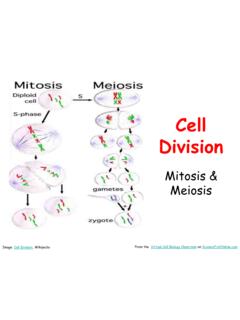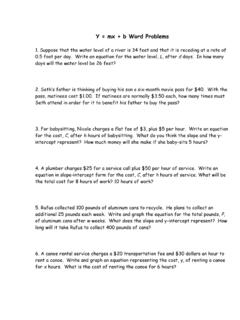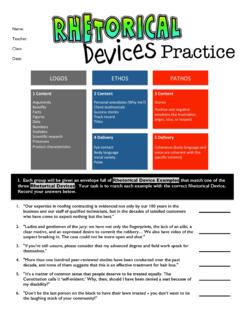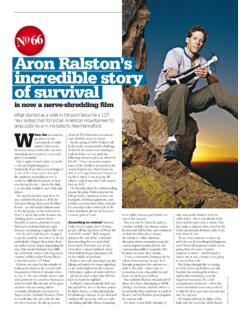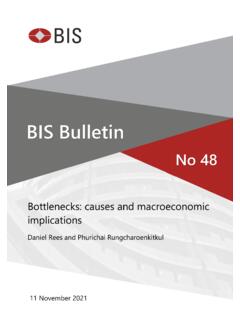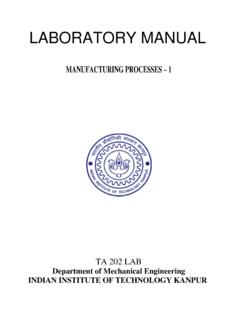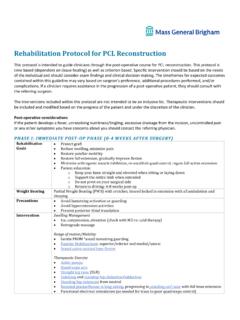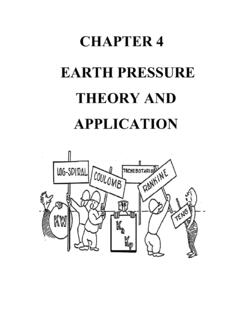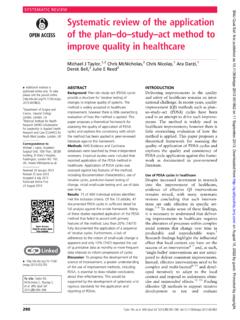Transcription of The Death of the Moth (1942) - San Juan Unified School ...
1 VIRGINIA WOOLFThe Death of the Moth (1942)Virginia Woolf (1882 1941) exposed the difficulties of being a woman writer in heressay A Room of One s Own. Her novels experimented with time and narrative,and she is considered a master of the stream-of-consciousness technique. Woolf bat-tled mental illnesses throughout her life, and eventually committed suicide bydrowning herself in 1941, a year before this essay was published. As you read, exam-ine the ways she presents images of life and that fly by day are not properly to be called moths; they do not excite thatpleasant sense of dark autumn nights and ivy-blossom which the commonest yel-low-underwing asleep in the shadow of the curtain never fails to rouse in are hybrid creatures, neither gay like butterflies nor somber like their ownspecies.
2 Nevertheless the present specimen, with his narrow hay-colored wings,fringed with a tassel of the same color, seemed to be content with life. It was apleasant morning, mid-September, mild, benignant, yet with a keener breaththan that of the summer months. The plough was already scoring the field oppo-site the window, and where the share had been, the earth was pressed flat andgleamed with moisture. Such vigor came rolling in from the fields and the downbeyond that it was difficult to keep the eyes strictly turned upon the book.
3 Therooks too were keeping one of their annual festivities; soaring round the tree topsuntil it looked as if a vast net with thousands of black knots in it had been cast upinto the air; which, after a few moments sank slowly down upon the trees untilevery twig seemed to have a knot at the end of it. Then, suddenly, the net wouldbe thrown into the air again in a wider circle this time, with the utmost clamorand vociferation, as though to be thrown into the air and settle slowly downupon the tree tops were a tremendously exciting same energy which inspired the rooks, the ploughmen, the horses, andeven, it seemed, the lean bare-backed downs, sent the moth fluttering from sideto side of his square of the windowpane.
4 One could not help watching him. One,was, indeed, conscious of a queer feeling of pity for him. The possibilities of plea-sure seemed that morning so enormous and so various that to have only a moth spart in life, and a day moth s at that, appeared a hard fate, and his zest in enjoy-ing his meager opportunities to the full, pathetic. He flew vigorously to one cor-ner of his compartment, and, after waiting there a second, flew across to theother. What remained for him but to fly to a third corner and then to a fourth?That was all he could do, in spite of the size of the downs, the width of the sky,the far-off smoke of houses, and the romantic voice, now and then, of a steamerout at sea.
5 What he could do he did. Watching him, it seemed as if a fiber, very1 From The Death of the Moth and Other Essaysby Virginia Woolf. Copyright 1942 by Harcourt, 1970 by Marjorie T. Parsons, Executrix. Reprinted by permission of the but pure, of the enormous energy of the world had been thrust into his frailand diminutive body. As often as he crossed the pane, I could fancy that a threadof vital light became visible. He was little or nothing but , because he was so small, and so simple a form of the energy that wasrolling in at the open window and driving its way through so many narrow andintricate corridors in my own brain and in those of other human beings, therewas something marvelous as well as pathetic about him.
6 It was as if someone hadtaken a tiny bead of pure life and decking it as lightly as possible with down andfeathers, had set it dancing and zigzagging to show us the true nature of life. Thusdisplayed one could not get over the strangeness of it. One is apt to forget allabout life, seeing it humped and bossed and garnished and cumbered so that ithas to move with the greatest circumspection and dignity. Again, the thought ofall that life might have been had he been born in any other shape caused one toview his simple activities with a kind of a time, tired by his dancing apparently, he settled on the window ledgein the sun, and, the queer spectacle being at an end, I forgot about him.
7 Then,looking up, my eye was caught by him. He was trying to resume his dancing, butseemed either so stiff or so awkward that he could only flutter to the bottom ofthe windowpane; and when he tried to fly across it he failed. Being intent onother matters I watched these futile attempts for a time without thinking, uncon-sciously waiting for him to resume his flight, as one waits for a machine, that hasstopped momentarily, to start again without considering the reason of its perhaps a seventh attempt he slipped from the wooden ledge and fell, flut-tering his wings, on to his back on the windowsill.
8 The helplessness of his attituderoused me. It flashed upon me that he was in difficulties; he could no longer raisehimself; his legs struggled vainly. But, as I stretched out a pencil, meaning to helphim to right himself, it came over me that the failure and awkwardness were theapproach of Death . I laid the pencil down legs agitated themselves once more. I looked as if for the enemy againstwhich he struggled. I looked out of doors. What had happened there? Presum-ably it was midday, and work in the fields had stopped. Stillness and quiet had re-placed the previous animation.
9 The birds had taken themselves off to feed in thebrooks. The horses stood still. Yet the power was there all the same, massed out-side, indifferent, impersonal, not attending to anything in particular. Somehow itwas opposed to the little hay-colored moth. It was useless to try to do could only watch the extraordinary efforts made by those tiny legs against anoncoming doom which could, had it chosen, have submerged an entire city, notmerely a city, but masses of human beings; nothing, I knew had any chanceagainst Death . Nevertheless after a pause of exhaustion the legs fluttered again.
10 Itwas superb this last protest, and so frantic that he succeeded at last in rightinghimself. One s sympathies, of course, were all on the side of life. Also, when therewas nobody to care or to know, this gigantic effort on the part of an insignificantlittle moth, against a power of such magnitude, to retain what no one else valuedor desired to keep, moved one strangely. Again, somehow, one saw life, a purebead. I lifted the pencil again, useless though I knew it to be. But even as I did so,2 WOOLFThe Death of the Moththe unmistakable tokens of Death showed themselves.





